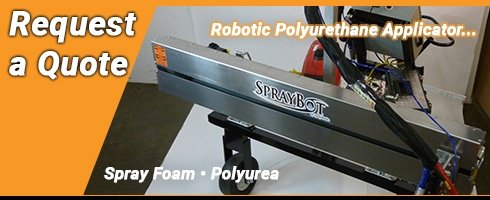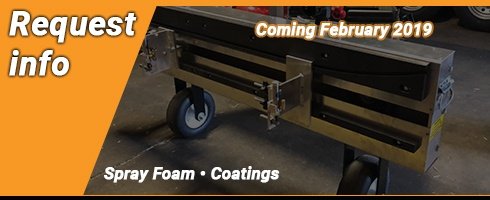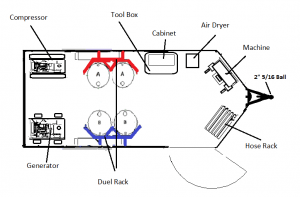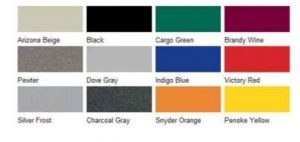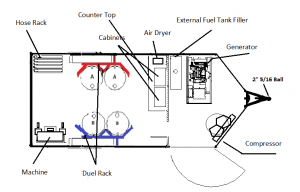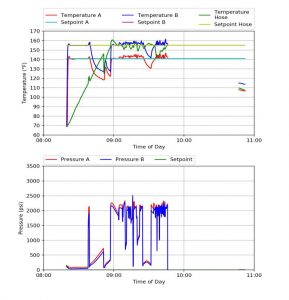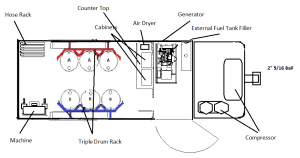Fluids subjected to heat in confined spaces, including hoses, can create a rapid rise in pressure due to the thermal expansion. Over-pressurization can result in equipment rupture and serious injury.
Category Archives: Tips from the Experts
Graco T3 Transfer Pump Packing
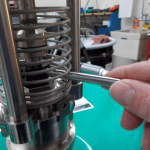
Material Spraying Issues
It’s less common when material will not spray on the ‘A’ side and ‘B’ side at the same time, but when it happens, there could be a number of factors at play. If you find yourself in this position, take a look at these common reasons;
- Proper operation of the pumping system. (execute initial startup checks)
- The product cold, it doesn’t flow properly.
- Failing delivery supply like transfer pump wear or neglect.
- Your regulator could be malfunctioning; Are you getting enough air supply to your Transfer Pump?
- Failing packings from wear or neglect.
- Clogged screens can also cause major issues in proper flow.
- Recent crossover in hose or contamination within the gun itself.
Reduce Pocketing in Studs
There are different ways to spray Open Cell foam to eliminate pocketing when spraying studs. Depending on the manufacturer you are using, they will recommend vertical or horizontal spray techniques – because of the chemical compound and how it settles in. For example; Rhino Linings recommends spraying horizontally with their Thermal Guard Open Cell. In doing so, I can improve my overall spray quality and deliver a better end-product.
Proper hose care
When heating up your hose, I highly recommend unravelling the bulk of it. There are two reasons why.
One – the hose will create hot spots and could potentially get to the point where the hose would melt and burst open after an extended period of time. The second reason – as you spray material, you’ll get inconsistent heat and as your material cures, your application will become poor and inconsistent.
Spray Gun Safety
Every gun has a safety feature. You should get in the habit of turning on the safety feature whenever you stop spraying – whether it’s to talk to someone or check your depth. It’s an often overlooked step when a new applicator is learning, but can quickly cause serious injury or damage if the spray gun releases unmanaged chemical.
Check your A Filter
I make it a habit to check my A Filter before I start every morning. To me, that’s the only way I can pressurize the machine and accurately read gauges to eliminate any problems. The reason I check the A Filter in the morning is, regardless of when the gun is cleaned the previous day, the cleaner tends to leave a layer of film on the screen.
Keep Your B-Side Going
The B Side, in general, is less likely to cause contamination in the screens. As a result, B Side screens are often neglected.
One possible cause of B Side pressure loss is the collection of paint chips over time. Spray foam drums are recyclable and during the recycling process, some of the drums are repainted inside. Over time, the B component can soften the paint in the drum, causing it to flake off and collect in the Y-filter assembly – restricting flow to the machine. Making the Y-filter assembly a priority to clean can help prevent the collection of paint chips.
Check your hose temp at multiple points
When I find my equipment is spraying just right, I grab a pocket thermometer. With a variety of elements including sun and fluctuating temps outside, that’s what I use to maintain the temperature between my gun and proportioner.
I always stick a pocket thermometer at the halfway point of my hose, so if there’s 200 feet I stick it in the sleeve at 100 feet. This way, if the material sprays a little off, I just check that thermometer to ensure the hose is the same temp all the way through.
The Importance of Maintaining Daily Logs
Daily job logs are vital to the operation of your foam company because they are a true gauge of productivity, profitability and your break-even point. Job logs assist your staff in cultivating positive documentation habits of their day to day job activity.
This in turn helps you and your crew maintain expensive equipment, track costly material and supplies, assure customer satisfaction, give the true story of actual time and material versus planned time and material, lets you know which builders are properly accommodating your staff and tracks all vital manufacturer required information.
All this information is easily tracked in a document that takes less than 10 minutes to fill out per day. If you’ve ever been involved in a nasty job-site litigation you know this is 10 minutes a day very well spent.
Robert Quesnette is the Territory Sales Manager for the Northeast region at Rhino Linings. Robert has more than 25 years experience in the insulation industry. He founded and operated one of the first foam companies in Connecticut and has experience with client training, building science and code seminars.

